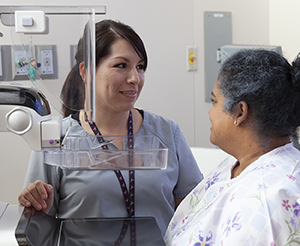Mammography
Mammography is an X-ray exam of your breast tissue. The image it makes is called a mammogram. It can help find problems with your breasts, such as cysts or cancer. Mammography is the best breast cancer screening tool available.

Be proactive
Have mammograms and breast exams as often as your healthcare provider advises. Also be sure you know how your breasts normally look and feel. This makes it easier to see any changes. Report changes to your provider as soon as you can. Finally, check your insurance to know what's covered.
Types of mammography
-
X-ray. Uses low dose X-ray to see breast tissue.
-
Digital. This uses electronics that convert X-rays into mammogram pictures of the breast. It uses less radiation.
-
Computer-aided detection (CAD). These look for abnormal areas of calcium deposits, and density.
-
3-D mammogram. Images of the breast from different angles are taken to make a 3-D image set.
How do I get ready for a mammogram?
-
Schedule the test for 1 week after your period. Your breasts are less sore and dense then.
-
Make sure your clinic gets images of your last mammogram if they were done somewhere else. This lets the provider compare the 2 sets of images for any changes.
-
On the day of your test, don’t use deodorant, powder, or perfume.
-
Wear a top that you can easily take off.
What happens during a mammogram?
-
You will need to undress from the waist up.
-
The technologist will position your breast to get the best results.
-
Each of your breasts will be compressed one at a time. This helps get the most complete image.
-
Your breasts will be repositioned to get at least 2 views of each breast.
What happens after a mammogram?
-
More X-rays or an ultrasound are sometimes needed. If not done at the time of your initial mammogram, you’ll be called to schedule them.
-
You should get your test results in writing. Ask about this at your appointment.
-
Have mammograms as often as your healthcare provider advises.
What to tell your provider
Tell your provider if:
-
You’re pregnant or think you could be
-
You have breast implants
-
You have any scars or moles on or near your breasts
-
You’ve had a breast biopsy or surgery
-
You’re breastfeeding
© 2000-2024 The StayWell Company, LLC. All rights reserved. This information is not intended as a substitute for professional medical care. Always follow your healthcare professional's instructions.